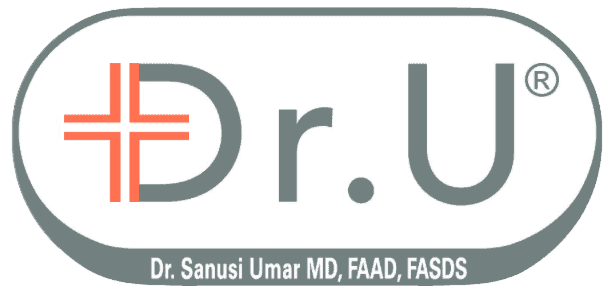This patient’s hair loss reached the Norwood Level-6 stage. He’d undergone a strip surgery at another clinic, but felt unsatisfied with the results. He still had a receded hairline, eroded temple points, and hair loss on the crown. Even worse, the strip surgery left him with noticeable scars on his head. Finally, he elected to see Dr. Umar to repair his bad strip surgery results using the Dr.UGraft™ method.
Hair Transplant Patient’s 12 Month Update- 4500 UGrafts of Beard and Head Hair
This gentleman had undergone a hair transplant repair to fix the unwanted results of a strip surgery performed at a different clinic. His surgery used a dono…
Before Dr.UGraft™ Procedure to Fix Poor Strip Surgery Growth
The patient made it clear to Dr. Umar that he wanted a restored hairline and temple points, as well as more hair coverage on the front and crown of his head. He also asked Dr. Umar to perform hair transplant scar concealment on his previous scarring.
The image below highlights the patient’s hair loss prior to the Dr.UGraft ™ surgery.
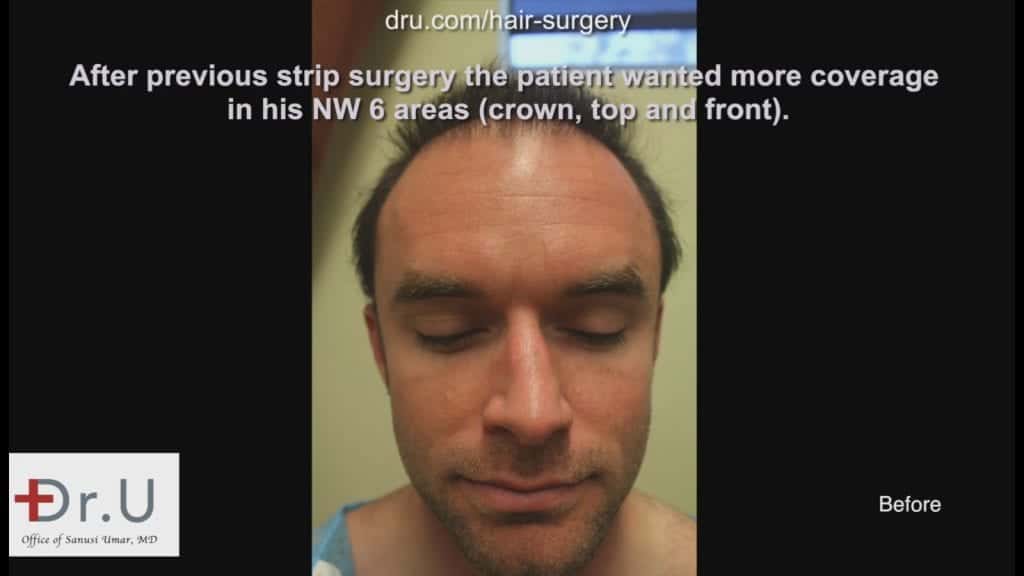
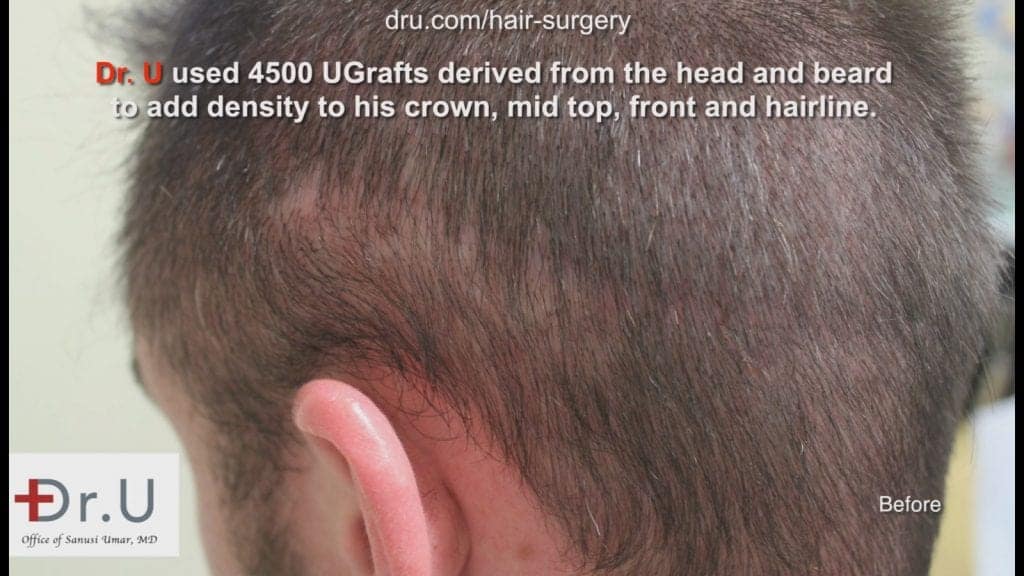
Procedure Photos: Dr.UGraft ™ Helps Newport Beach Patient Fix Poor Strip Surgery Growth
Dr. Umar carefully selected 4500 Dr.UGrafts™ from the patient’s head and beard to repair his bad strip surgery results. He designed his Dr.UGraft ™ technology to overcome the factors that stand in the way of safe extractions of body hairs, like beard hair grafts. One of his devices is the Dr.UPunch i ™ (The Intelligent Punch) which has extra features to gently pull sharply angled hairs upwards as the rotary punch cuts around the follicular unit. Standard Follicular Unit Extraction punches, on the other hand lack the innate ability to trace the angle of the follicle. Without the pulling feature, these punches will continue to descend along the same cutting trajectory and cut through the graft, rendering it useless.
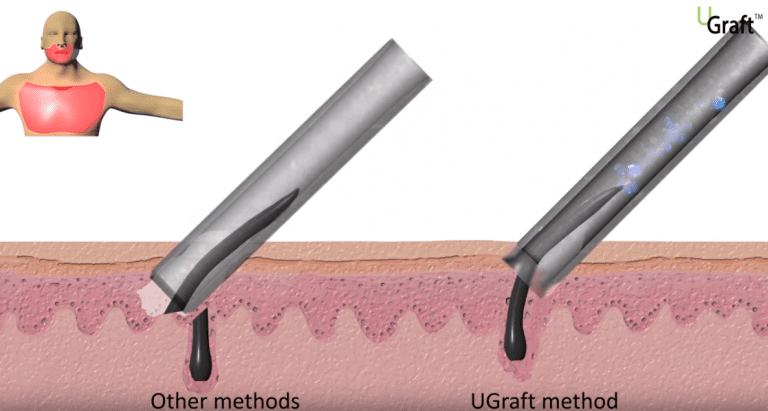
Once Dr. Umar harvested the patient’s donor pool of head and beard hair grafts, he transplanted the hair to the crown, adding thickness and density to the area. Dr. Umar then went about rebuilding the hairline and temple region for the most natural look possible. He also transplanted hair to the scar region for better concealment.
The photos below contrasts the difference before and after surgery.
Before and After Dr.UGraft ™ Body Hair Transplant with 4500 Grafts
Twelve months after surgery, the patient had a head of thick, natural looking hair without visible scarring or complications. The hair added to the crown matches the natural thickness, coarseness and whirl of the existing hair. He also has a more defined hairline and temple points. Even better, the hair transplanted to the scar tissue completely camouflages the area. The patient has no sign of scarring to the naked eye!
The photo below highlights the difference before and after surgery.
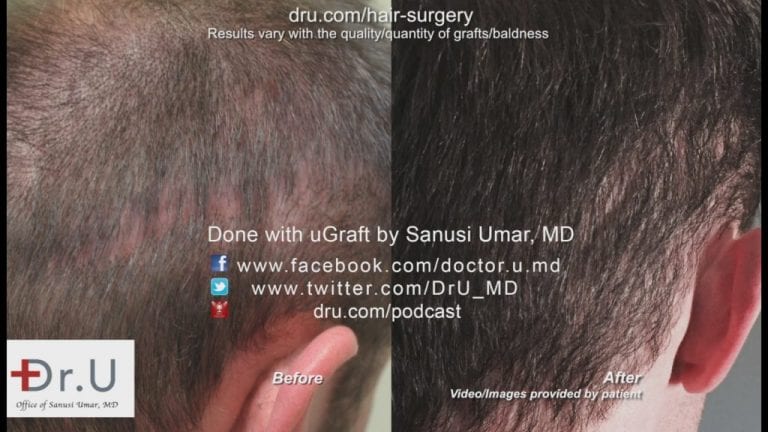
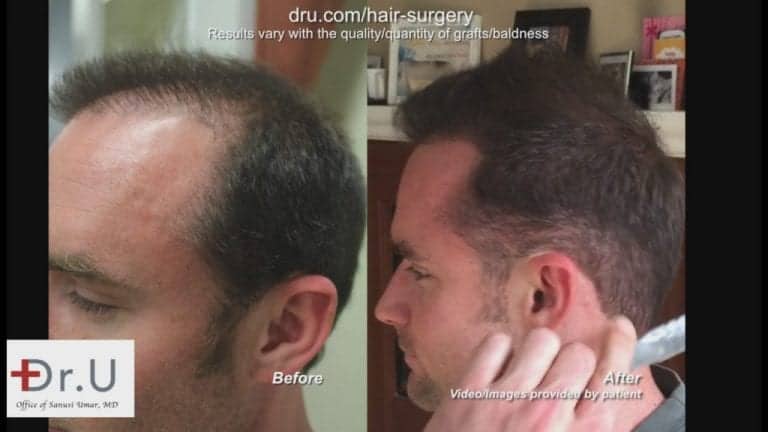
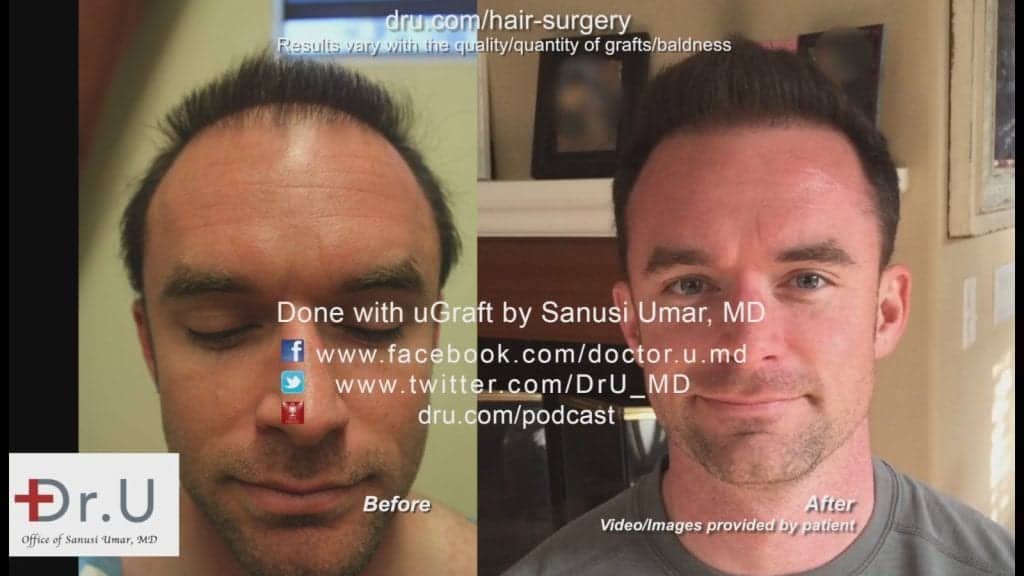
Needless to say, the patient expressed his happiness at the results of FUE hair transplant with the DrUGraft ™ . He has finally achieved the coverage and the youthful looking appearance that he sought. Without having to worry about a strip scar, he can finally wear a classic looking hair cut with the back and sides short.
Video: Strip Scar Concealment with Dr.UGraft ™FUE for Newport Beach, Los Angeles Patient
Learn more about the patient’s experience with his Dr.UGraft ™ hair transplant using beard and head hair grafts by watching this video. Unhappy with his bad strip surgery results, this Newport Beach patient turned to Dr. U in Los Angeles.
[dt_button link=”/hair-surgery/free-consultation/” target_blank=”false” button_alignment=”center” animation=”fadeIn” size=”big” style=”default” bg_color_style=”default” bg_hover_color_style=”default” text_color_style=”default” text_hover_color_style=”default” icon=”fa fa-chevron-circle-right” icon_align=”left”]FREE CONSULTATION[/dt_button]
Frequently Asked Questions: Repair Bad Strip Surgery Results with the Dr.UGraft ™
I’ve undergone strip surgery and I’m also unhappy with the results. I’ve been told I have a depleted donor area. Can the DrUGraft help me?
Yes! The unique design of the DrUGraft ™ allows for body hair transplant (BHT), which means Dr. Umar can transplant hair from anywhere on the body. This vastly increases the donor pool beyond head hair, and allows Dr. Umar to treat even severely bald patients.
Does the Dr.UGraft require hospitalization? How long does it take to recover?
The DrUGraft™ is a minimally – invasive procedure performed in Dr. Umar’s Los Angeles office. It basically uses more advanced punch extraction technology in place of regular Follicular Unit Extraction punches. Like other FUE procedures, it only requires only local anesthesia. No hospitalization is needed. Patients can return to day-to-day life immediately following surgery. Wounds from the surgery scab and crust over, closing about a week later. In general, it takes about a month for the tiny wounds to heal. Hair growth begins thereafter, with full hair reaching full growth after about a year’s time.
Is is always necessary to use beard hair grafts for more coverage? Or can other types of hair be used?
Beard hair is typically chosen because many individuals are able to supply a very large number of them. However, when there is not enough head hair, and if beard hair is ruled out as an option, it is also possible to use hair from the chest, abdomen back and any other area of the body that would be a good match for scalp hair.
No matter how hopeless you may feel about your case, Dr. U will be able to help restore your life and confidence. For any additional questions, we have an online portal that allows you to ask him any questions you may have:
[dt_button link=”/hair-surgery/ask-dr-umar/” target_blank=”false” button_alignment=”center” animation=”fadeIn” size=”big” style=”default” bg_color_style=”default” bg_hover_color_style=”default” text_color_style=”default” text_hover_color_style=”default” icon=”fa fa-chevron-circle-right” icon_align=”left”]ASK DR. U[/dt_button]
Further Reading:
Learn how Dr. Umar repairs different types of mistakes from previous hair transplants
Read Dr. Umar’s research publication on body hair transplantation featured in Facial Plastic Surgery
